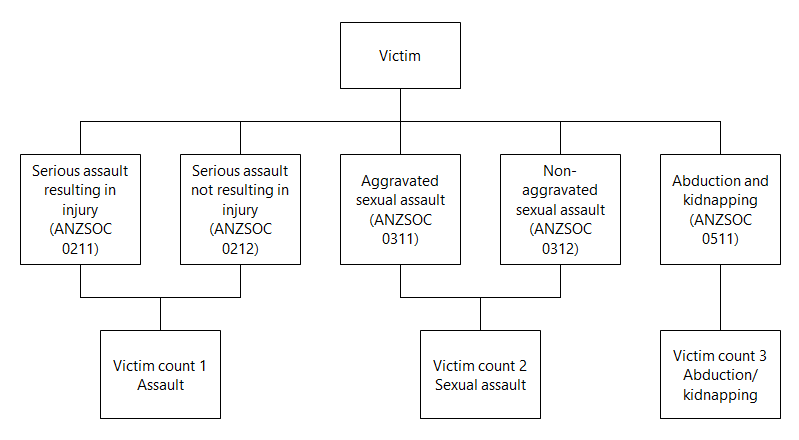Recorded Crime – Victims presents statistics relating to victims of crime for a selected range of offences as recorded by police. These offences may have been reported by a victim, witness or other person, or they may have been detected by police. These statistics are not designed to provide a total count of unique victims, nor the total number of individual offences that came to the attention of police.
Statistics in this publication are:
- created from data held in administrative systems which is collected and maintained by police agencies within each state and territory
- collected by the ABS and compiled according to the National Crime Recording Standard in order to maximise consistency between states and territories
- produced annually on a calendar year basis
Scope
The scope of this collection includes victims of offences classified to selected divisions and/or subdivisions of the Australian and New Zealand Standard Offence Classification (ANZSOC). A victim can be a person, premises, organisation, or motor vehicle depending on the type of offence.
Selected offence categories are:
- homicide and related offences (including murder, attempted murder and manslaughter, but excluding driving causing death and conspiracy to murder) - ANZSOC division 01
- assault - ANZSOC subdivision 021
- sexual assault - ANZSOC subdivision 031
- abduction and kidnapping - ANZSOC subdivision 051
- robbery - ANZSOC subdivision 061
- blackmail and extortion - ANZSOC subdivision 062
- unlawful entry with intent/burglary, break and enter - ANZSOC division 07
- motor vehicle theft - ANZSOC groups 0811 and 0812
- other theft - ANZSOC groups 0813, 0821, 0823, 0829 and 0841
Statistics in this publication relate to both completed and attempted offences, i.e. those where the intent is not fulfilled. Attempts to commit an offence are classified to the same ANZSOC divisions and/or subdivisions as completed offences, except for:
- murder, where murder and attempted murder are distinguished as separate offence categories
- attempted motor vehicle thefts due to difficulties in distinguishing these offences from criminal damage
The scope excludes the following:
- conspiracy offences
- threats to commit an offence (an exception to this exclusion is assault where there is an apprehension that the direct threat of force, injury, or violence could be enacted, which is in-scope of the collection. This also applies to offences like robbery, kidnapping/abduction and blackmail/extortion where an element of threat is implicit in the nature of the crime)
- aid, abet and accessory offences
- deprivation of liberty offences
- Where an outcome of investigation determines ‘no crime’ was committed i.e. the offence was reported to police but later deemed to be unfounded, false, or baseless; counts are excluded from the data.
- Victims of crime as recorded by the Australian Federal Police (AFP). As such, victims of crime in Australia’s ‘other territories’ such as Christmas Island, the Cocos (Keeling) Islands and Jervis Bay Territory are out of scope as these territories are under AFP jurisdiction.
